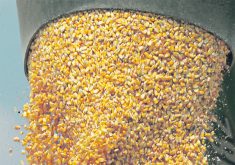Everyone out of the pool.
The familiar call from lifeguards could well be adopted as a prudent wheat marketing strategy for prairie farmers this spring, say market analysts.
While no one is suggesting that all farmers abandon the Canadian Wheat Board’s price pools, they are saying that producers would be well advised to closely monitor strong, but fluctuating wheat futures prices and seriously consider using the CWB’s fixed price contract on rallies.
On one day last week, farmers could have used the fixed price contract, or FPC, to lock in a price $13 a tonne above the 2006-07 pool return outlook for good quality hard red spring wheat.
Read Also

Chinese, Indian tariffs take toll on pea prices
The disruption of pea exports from Canada’s largest customers will likely result in slow pea exports for the remainder of the crop year.
Even higher premiums were available for other wheats, ranging as high as $24 a tonne for Canada Prairie Spring red and white and CW hard red winter.
“That’s a really strong signal to price an FPC and get out of the pool,” said Brenda Tjaden-Lepp of FarmLink Marketing Solutions.
“The board is saying ‘I’ll give you $20 a tonne more now than I think I can get you at the end of the year.’ It seems like a no-brainer.”
The PRO reflects the pooled price of the grain sold by the board over the course of the 2006-07 marketing year, which could include sales as far away as the summer of 2007. While the PRO changes throughout the year, it’s unlikely to increase by $20 a tonne, say analysts.
Another benefit of the FPC is that the full payment is made within 10 days of delivery.
After peaking and then crashing in mid-March, wheat futures again climbed early last week, largely on fears of drought in the U.S. southern plains and wet soils in North Dakota.
However analysts say the strong futures price could encourage farmers to seed more spring wheat, causing futures to fall. A change in the weather forecast could also send the market down again as it did April 17.
“This could burn out by the end of April,” said Errol Anderson of ProMarket Commodities.
Also, some analysts believe that $4.50 per bushel represents a “resistance” level in the market, beyond which the price won’t go unless there is a significant new bullish development.
Anderson expects to see a lot of aggressive forward pricing by farmers over the next week or two.
“It’s a great opportunity,” he said. “I would go minimum 20 percent of my crop, and the more aggressive producer might want to go 30 to 40 percent.”
Analyst Mike Jubinville of Pro Farmer Canada noted that wheat futures were reaching historically high levels last week.
“Once we get into the area we’re in now, of $4.40 to $4.50 US a bushel on the nearby contracts, we’re getting into the top 10 percent of where the contract has traded in the past 30 years,” he said.
“We’re getting into territory where I think farmers can generate and secure a profit on this year’s wheat crop.”
John Pauch, who works on producer pricing option programs for the CWB, said about 500,000 tonnes had been signed up for 2006-07 fixed price or basis contracts by April 11. The highest tonnage ever was 1.2 million tonnes in 2004-05. He said it’s almost impossible to predict how much tonnage will be signed up over the course of the spring, given the uncertainty about future price trends.
“It really depends on how long the rally stays,” he said, adding that farmers can sign up for an FPC until Nov. 1, 2006.
Farmers considering an FPC need to look at their costs of production and break-even price on their farm, and keep an eye on exchange rates, U.S. futures prices and world production.














